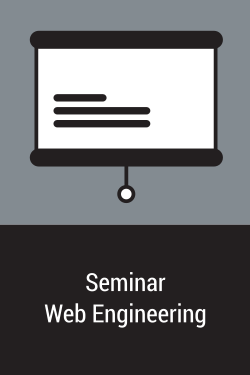
Web Engineering Seminar (WS 2025/2026)
Welcome to the homepage of the Web Engineering Seminar
This website contains all important information about the seminar, including links to available topics as well as information about the seminar process in general.
The interdisciplinary research area Web Engineering develops approaches for the methodological construction of Web-based applications and distributed systems as well as their continuous development (evolution). For instance, Web Engineering deals with the development of interoperable Web Services, the implementation of web portals using service-oriented architectures (SOA), fully accessible user interfaces or even exotic web-based applications that are voice controlled via the telephone or that are represented on TV and Radio.
The following steps are necessary to complete the seminar:
- Preparation of a presentation about the topic assigned to you.
- An additional written report of your topic.
- Each report is reviewed by two or three other particpants.
Seminar chairs

Verena Traubinger M.Sc.

Christoph Göpfert M.Sc.

Dr.-Ing. Sebastian Heil
Contact
If you have any questions concerning this seminar or the exam as a participant, please contact us via OPAL.
We also offer a Feedback system, where you can provide anonymous feedback for a partiular session to the presenter on what you liked or where we can improve.
Participants
The seminar is offered for students of the following programmes (for pre-requisites, please refer to your study regulations):
- Master Web Engineering (500410 Seminar Web Engineering)
Students who are interested in the Pro-, Haupt or Forschungsseminar (applies to all other study courses) will find all information here .
If your programme is not listed here, please contact us prior to seminar registration and indicate your study programme, the version (year) of your study regulations (Prüfungsordnungsversion) and the module number (Modulnummer) to allow us to check whether we can offer the seminar for you and find an appropriate mapping.
Registration
You may only participate after registration in the seminar course in OPAL
The registration opens on 01.10.2025 and ends on 12.10.2025 at 23:59. As the available slots are usually rather quickly booked, we recommend to complete your registration early after registration opens.
Topics and Advisors
Questions:
- What are the conceptual differences between RDF triple stores and property graph databases?
- How do their query languages compare?
- What are the key performance and scalability findings from recent benchmarks?
- How do visualization tools affect usability?
- What are the current challenges in benchmarking graph databases?
Literature:
- Own research
- A. Hogan et al., "Knowledge Graphs," ACM Computing Surveys, vol. 54, no. 4, pp. 1–72, Aug. 2021. [Online]. Available: https://dl.acm.org/doi/10.1145/3447772
- A. Bonifati, G. Franzosi, and M. Montali, Querying Graphs. Morgan & Claypool, 2018. [Online]. Available: https://perso.liris.cnrs.fr/abonifat/pubs/book-Bonifati-et-al-18.pdf
- LDBC Council, "LDBC Social Network Benchmark (SNB): Specification," 2020. [Online]. Available: https://ldbcouncil.org/ldbc_snb_docs/ldbc-snb-specification.pdf
- C. Bizer and A. Schultz, "The Berlin SPARQL Benchmark," IJ on Semantic Web & Information Systems, vol. 5, no. 2, pp. 1–24, 2009. [Online]. Available: https://pdfs.semanticscholar.org/ce7c/0f329c93f652135ee765d74e9c8e6db7908d.pdf
- W. Ali, V. Chawla, and R. A. Khan, "A Survey of RDF Stores & SPARQL Engines for Querying Knowledge Graphs," arXiv:2102.13027, 2021. [Online]. Available: https://arxiv.org/pdf/2102.13027.pdf
Questions:
- What are the main ontology engineering methodologies?
- How do their steps, reusability, and adaptability compare?
- What roles do competency questions and design patterns serve?
- How are these methods used in industry projects?
- What challenges arise when applying academic methods in practice?
Literature:
- Own research
- N. F. Noy and D. L. McGuinness, "Ontology Development 101: A Guide to Creating Your First Ontology," Stanford KSL, 2001. [Online]. Available: https://protege.stanford.edu/publications/ontology_development/ontology101.pdf
- M. Fernández-López, A. Gómez-Pérez, and J. P. Sierra, "METHONTOLOGY: From Ontological Art to Ontological Engineering," AAAI SS, 1997. [Online]. Available: https://aaai.org/papers/0005-ss97-06-005-methontology-from-ontological-art-towards-ontological-engineering/
- M. C. Suárez-Figueroa, "NeOn Methodology for Building Ontology Networks," Universidad Politécnica de Madrid, 2010. [Online]. Available: https://oa.upm.es/3879/2/MARIA_DEL-_CARMEN_SUAREZ_DE_FIGUEROA_BAONZA.pdf
- C. Arp, B. Smith, and A. Spear, Building Ontologies with Basic Formal Ontology. MIT Press, 2015. [Online]. Available: https://mitpress.mit.edu/9780262527811/building-ontologies-with-basic-formal-ontology/
Questions:
- What are User Journeys? What is User Journey Mapping? What are Use Cases? How can they help to identify requirements of web applications?
- How can User Journeys, User Journey Maps and Use Cases be created?
- With the example of the Across eCampus, conduct some interviews with potential users of the Across eCampus (e.g. students, staff members) and create User Journeys, User Journey Maps and Use Cases from them. Present your findings.
Literature:
- T. Howard, “Journey mapping: A brief overview,” Communication Design Quarterly Review, vol. 2, no. 3, pp. 10–13, 2014.
- A. Endmann and D. Keßner, “User journey mapping–a method in user experience design,” i-com, vol. 15, no. 1, pp. 105–110, 2016.
- L. L. Constantine and L. A. Lockwood, “Structure and style in use cases for user interface design,” Object modeling and user interface design, pp. 245–280, 2001.
- Own research
Questions:
- How can AI be used to provide automatic translation of user generated content in web applications?
- Can available context information for the user generated content improve the quality of translation?
- Implement a prototype in the context of the Across eCampus, where course/event information provided by users should be automatically translated.
Literature:
- Own research
Questions:
- What are the various criteria and measures currently used to evaluate knowledge graph quality, linked data quality, and general data quality?
- How do different quality assessment catalogs overlap or interrelate in terms of their criteria?
- Which of these catalogs and frameworks are currently considered state-of-the-art, and which might be outdated or less relevant?
- What combination of quality criteria is most suitable for evaluating knowledge graphs, considering distinctions between semantic and technical perspectives?
Literature:
- A. Nayak, B. Božić, and L. Longo, “Linked Data Quality Assessment: A Survey,” Lecture Notes in Computer Science. Springer International Publishing, pp. 63–76, 2022. doi: 10.1007/978-3-030-96140-4_5.
- “Linked Data - Design Issues,” W3.org, 2009. https://www.w3.org/DesignIssues/LinkedData.html.
- M. D. Wilkinson et al., “The FAIR Guiding Principles for scientific data management and stewardship,” Sci Data, vol. 3, no. 1, Mar. 2016, doi: 10.1038/sdata.2016.18.
- Research Data Alliance FAIR Data Maturity Model Working Group, “FAIR Data Maturity Model: specification and guidelines,” Research Data Alliance, 2020, doi: 10.15497/RDA00050.
- H. Hussein, A. Oelen, O. Karras, and S. Auer, “KGMM -- A Maturity Model for Scholarly Knowledge Graphs based on Intertwined Human-Machine Collaboration,” 2022, arXiv. doi: 10.48550/ARXIV.2211.12223.
- A. Zaveri, A. Rula, A. Maurino, R. Pietrobon, J. Lehmann, and S. Auer, “Quality assessment for Linked Data: A Survey,” SW, vol. 7, no. 1, pp. 63–93, Mar. 2015, doi: 10.3233/sw-150175.
- “ISO 25012,” Iso25000.com, 2024. https://iso25000.com/index.php/en/iso-25000-standards/iso-25012?start=10.
- D. M. Strong, Y. W. Lee, and R. Y. Wang, “Data quality in context,” Commun. ACM, vol. 40, no. 5, pp. 103–110, May 1997, doi: 10.1145/253769.253804.
- R. Albertoni, A. Isaac, “Data on the Web Best Practices: Data Quality Vocabulary”, W3C Working Group Note, W3C, 2016, https://www.w3.org/TR/vocab-dqv/.
- H. Hussein, A. Oelen, O. Karras, and S. Auer, “Knowledge Graph Maturity Model,” Jun. 25, 2022, Zenodo. doi: 10.5281/ZENODO.6732786.
- Own research
Questions:
- What is the WebComposition Architecture Model (WAM)?
- What are the main components and concepts modeled in WAM?
- Why is Across eCampus a suitable use case for applying the WAM?
- Create WAM diagrams for the Across eCampus use case.
Literature:
- J. Meinecke and M. Gaedke, "Modeling federations of Web applications with WAM," Third Latin American Web Congress (LA-WEB'2005), Buenos Aires, Argentina, 2005, pp. 9 pp.-, doi: 10.1109/LAWEB.2005.22.
- Own research
Questions:
- Introduction: In modern research infrastructures, isolated data silos hinder seamless knowledge exchange. Here ontology mappings come into play, like mappings to the Basic Formal Ontology (BFO) for philosophically grounded semantic interoperability, OpenAIRE for pragmatic integration within the European Open Science Cloud ecosystem, and the Kerndatensatz Forschung (KDSF) as a core metadata standard for research data.
- What are the primary purposes and fundamental concepts of BFO, Openaire, and KDSF? How do these frameworks shape the European research and education data ecosystem?
- What approaches and best practices exist for amending an existing ontology to achieve conformance with BFO, Openaire, and KDSF standards? What challenges arise in this process?
- In the context of the Across ontology as a use case, how can it be systematically mapped to BFO, Openaire, and KDSF?
- Prepare a comprehensive mapping document for the Across ontology mapping.
Literature:
- ISO/IEC 21838-2:2021, Top-level Ontologies – Part 2: Basic Formal Ontology (BFO). International Organization for Standardization, 2021. Online. Available: https://www.iso.org/standard/74572.html
- OpenAIRE Guidelines — Release 3.0, OpenAIRE, 2019. Online. Available: https://guidelines.openaire.eu/en/latest/
- Kerndatensatz Forschung (KDFS) – Offizielle Spezifikationen. Online. Available: https://www.kerndatensatz-forschung.de
- Own research
Questions:
- What is machine unlearning? What is the decenralized web?
- How machine unlearning can be used in the decentralized web?
- Show a demo using machine unlearning on SOLID Pods data
Literature:
- Own research
Questions:
- What is a Brain-Computer Interface (BCI) and how does it function?
- In which areas or applications can BCI technology be implemented?
- Design a demonstration using BCI technology for user interaction or cognitive monitoring. (The necessary hardware can be provided by the supervisor).
Literature:
- Own research
Questions:
- Which real-world use cases and applications exist for Semantic Web technologies outside academia, and what business or organizational problems do they address?
- Which Semantic Web technologies and standards are employed in these applications? (e.g. RDF/RDFS, OWL, SPARQL, JSON-LD, specific ontologies, RDF triple stores)
- What advantages do RDF-based Semantic Web approaches provide over traditional solutions in these contexts?
- What evidence exists for the success and impact of these applications? (quantitative metrics, qualitative benefits, business value)
- What challenges arise in implementing RDF-based Semantic Web technologies in industry, and what lessons can be derived from existing deployments?
Literature:
- Own research
Questions:
- What guidelines and principles exist to safeguard Good Research Practice?
- How can these guidelines and principles be integrated into the research process?
- What is scientific misconduct/scientific malpractice?
- What is considered "high-quality research"? What are indicators thereof?
Literature:
- Own Research
- The European Code of Conduct for Research Integrity http://www.allea.org/wp-content/uploads/2017/03/ALLEA-European-Code-of-Conduct-for-Research-Integrity-2017-1.pdf
- Guidelines for Safeguarding Good Research Practice https://www.dfg.de/download/pdf/foerderung/rechtliche_rahmenbedingungen/gute_wissenschaftliche_praxis/kodex_gwp_en.pdf
- https://erc.europa.eu/sites/default/files/document/file/ERC_info_document-Open_Research_Data_and_Data_Management_Plans.pdf
Questions:
- Chatbot Interaction Patterns are used in the graphical interface of chatbots and provide the users with known interaction elements which can make the interaction easier. Explain the term Chatbot Interaction Patterns and show some examples.
- You will receive access to a dataset of chatbots and chatbot interactions, as well as an empty codebook with chatbot interaction patterns. Make yourself familiar with these pattern and understand how they are used.
- Each student must analyse the complete dataset accordingly to the provided labels (patterns and metadata), first on their own, and then compare their labeling with their partner. The dataset mostly includes screenshots, and video recordings of chatbot interactions. Detailed instructions will be provided in a meeting with the advisor.
- Present a statistical analysis of your results like frequency and distribution of patterns, dependencies of patterns (i.e. which ones depend on others, etc) and more. Choose sensible statistical methods for this and also use them not only on the complete datasets but also on each dataset on its own. Use diagrams, tables, and visual examples in your presentation.
Literature:
- Own research
- Unpublished research (will be provided)
- Traubinger, V., Gaedke, M. (2024). Interaction Design Patterns of Web Chatbots. In: Stefanidis, K., Systä, K., Matera, M., Heil, S., Kondylakis, H., Quintarelli, E. (eds) Web Engineering. ICWE 2024. Lecture Notes in Computer Science, vol 14629. Springer, Cham. https://doi.org/10.1007/978-3-031-62362-2_22
- Lorenz Cuno Klopfenstein, Saverio Delpriori, Silvia Malatini, and Alessandro Bogliolo. 2017. The Rise of Bots: A Survey of Conversational Interfaces, Patterns, and Paradigms. In Proceedings of the 2017 Conference on Designing Interactive Systems (Edinburgh, United Kingdom) (DIS ’17). Association for Computing Machinery, New York, NY, USA, 555–565. https://doi.org/10.1145/3064663.3064672
Hints/Questions:
- Familiarize yourself with both ShEx and SHACL.
- Analyze similarities, differences, (design principles, tool support, expressivity, performance, etc.)
- Identify contexts in which one approach is more suitable.
Literature:
- Own research
Hints/Questions:
- How can non-textual modalities be effectively represented and linked?
- What are the main challenges in aligning and reasoning over MMKGs?
- What are promising use cases for MMKG?
Literature:
- Own research
Questions:
- What are differnt AI methods for pattern recognition in different modalities (text, images, ...)? Present and explain them.
- How can these be used to recognize chatbots on websites? What would you need to know about this?
- Research on typical chatbot implementations by searching for literature and conducting an analysis of chatbot instances.
- Search for different models, tools, and projects which could be used for this task.
Literature:
- Own research
- Theodoridis, S., & Koutroumbas, K. (2006). Pattern recognition. Elsevier.
- Traubinger, V., Heil, S., Grigera, J., Garrido, A., Abhyankar, S., Gaedke, M. (2025). An Analysis of Federal and Municipal Chatbots in Germany. In: Følstad, A., et al. Chatbots and Human-Centered AI. CONVERSATIONS 2024. Lecture Notes in Computer Science, vol 15545. Springer, Cham. https://doi.org/10.1007/978-3-031-88045-2_13
- Traubinger, V., Gaedke, M. (2024). Interaction Design Patterns of Web Chatbots. In: Stefanidis, K., Systä, K., Matera, M., Heil, S., Kondylakis, H., Quintarelli, E. (eds) Web Engineering. ICWE 2024. Lecture Notes in Computer Science, vol 14629. Springer, Cham. https://doi.org/10.1007/978-3-031-62362-2_22
- Waheed, N., Ikram, M., Hashmi, S.S., He, X., Nanda, P. (2022). An Empirical Assessment of Security and Privacy Risks of Web-Based Chatbots. In: Chbeir, R., Huang, H., Silvestri, F., Manolopoulos, Y., Zhang, Y. (eds) Web Information Systems Engineering – WISE 2022. WISE 2022. Lecture Notes in Computer Science, vol 13724. Springer, Cham. https://doi.org/10.1007/978-3-031-20891-1_23
Questions:
- What is a real-time data pipeline, and how is it different from batch processing?
- How can knowledge graphs be integrated into real-time pipelines?
- What are the main advantages?
- What are the main limitations ?
- Which tools are available today, and what are their roles?
Literature:
- Own research
- F. Dell’Aglio et al., “Stream Reasoning: A Survey,” Semantic Web Journal, 2017. [Online]. Available: https://www.cs.vu.nl/~frankh/postscript/DataScience2017.pdf
- D. F. Barbieri et al., “C-SPARQL: A Continuous Query Language for RDF Data Streams,” Semantic Web Journal, vol. 4, no. 1, pp. 3–25, 2010. [Online]. Available: https://kops.uni-konstanz.de/bitstreams/a0532502-1f82-4933-b9bd-37e238831cac/download
- X. Ren and O. Curé, “Strider: A Hybrid Adaptive Distributed RDF Stream Processing Engine,” Proc. ISWC, Vienna, 2017, pp. 559–576. [Online]. Available: https://iswc2017.semanticweb.org/wp-content/uploads/papers/MainProceedings/158.pdf
- A. Hogan et al., “Knowledge Graphs,” ACM Computing Surveys, vol. 54, no. 4, pp. 1–72, Aug. 2021. [Online]. Available: https://dl.acm.org/doi/10.1145/3447772
Questions:
- What are typical ways to select UI languages in websites?
- How do different approaches for selecting UI language on first visit compare?
- How can automatic AI-based translation be integrated in the UI design of websites next to manual translation? How can the fact that the translation is automatic and not necessarily supported be made visible to the users?
Literature:
- Own research
Hints/Questions:
- What are the objectives of SHACL and how are they achieved?
- In which real-world scenarios and use cases is SHACL employed?
- Compare the Shapes Constraint Language to the Shape Expressions Language.
Literature:
- https://www.w3.org/TR/shacl/
- Own research
Questions:
- What is Retrieval Augmented Generation (RAG)?
- What are benefits and drawbacks of RAG?
- How can RAG be implemented? Find and compare different approaches and technologies used for RAG. Present your findings.
Literature:
- Y. Gao et al., “Retrieval-augmented generation for large language models: A survey,” arXiv preprint arXiv:2312.10997, vol. 2, no. 1, 2023.
- Own research
Questions:
- Make yourself familiar with the method of a Systematic Literature Review and conduct one on the topic of user interface elements of chatbots.
- What are the main topics of the research on chatbot interfaces?
- Which interface elements are present in the literature? How are they named and described?
- Are there differences between "classical" chatbots and LLM chatbots?
Literature:
- Kitchenham, B. (2004). Procedures for Undertaking Systematic Reviews. https://www.inf.ufsc.br/~aldo.vw/kitchenham.pdf
- Brereton, P., Kitchenham, B. a., Budgen, D., Turner, M., & Khalil, M. (2007). Lessons from applying the systematic literature review process within the software engineering domain. Journal of Systems and Software, 80(4), 571–583.
- Petersen, K., Vakkalanka, S., & Kuzniarz, L. (2015). Guidelines for conducting systematic mapping studies in software engineering: An update. Information and Software Technology, 64, 1–18.
- A. Hinderks, F. José, D. Mayo, J. Thomaschewski and M. J. Escalona, "An SLR-Tool: Search Process in Practice : A tool to conduct and manage Systematic Literature Review (SLR)," 2020 IEEE/ACM 42nd International Conference on Software Engineering: Companion Proceedings (ICSE-Companion), 2020, pp. 81-84.
- Own research
Questions:
- Familiarize yourself with Retrieval-Augmented Generation (RAG) and Knowledge-Augmented Generation (KAG).
- Which limitations of RAG does KAG address and how is this realized?
- Which Knowledge Graphs can be used for the KAG approach? What are requirements with regard to ontological structure, date quality or scale?
- What are use cases that benefit the most from KAG?
Literature:
- L. Liang et al., “KAG: Boosting LLMs in Professional Domains via Knowledge Augmented Generation,” Sept. 26, 2024, arXiv: arXiv:2409.13731. doi: 10.48550/arXiv.2409.13731.
- P. Yi et al., “KGFabric: A Scalable Knowledge Graph Warehouse for Enterprise Data Interconnection,” Proc. VLDB Endow., vol. 17, no. 12, pp. 3841–3854, Aug. 2024, doi: 10.14778/3685800.3685810.
- Own research
Seminar Opening
The date and time of the seminar opening meeting will be announced via OPAL.
Short Presentation
The date and time of the short presentations will be announced via OPAL.
In your short presentation, you will provide a brief overview on your selected topic.
This includes the following aspects:
- What is in your topic?
- Which literature sources did you research so far?
- What is your idea for a demonstration?
Following your short presentations, the advisors will provide you with feedback and hints for your full presentations.
Hints for your Presentation
- As a rule of thumb, you should plan 2 minutes per slide. A significantly higher number of slides per minute exceeds the perceptive capacity of your audience.
- Prior to your presentation, you should consider the following points: What is
the main message of my presentaion? What should the listeners take away?
Your presentation should be created based on these considerations. - The following site provides many good hints: http://www.garrreynolds.com/preso-tips/
Seminar Days
The date and time of the seminar opening meeting will be announced via OPAL.
Report
- Important hints on citing:
- Any statement which does not originate from the author has to be provided with a reference to the original source.
- "When to Cite Sources" - a very good overview by the Princeton University
- Examples for correct citation can be found in the IEEE-citation reference
- Web resources are cited with author, title and date including URL and
Request date. For example:
- [...] M. Nottingham and R. Sayre. (2005). The Atom Syndication Format - Request for Comments: 4287 [Online]. Available: http://www.ietf.org/rfc/rfc4287.txt (18.02.2008).
- [...] Microsoft. (2015). Microsoft Azure Homepage [Online]. Available: http://azure.microsoft.com/ (23.09.2015).
- A url should be a hyperlink, if it is technically possible. (clickable)
- Further important hints for the submission of your written report:
- Use apart from justifiable exceptions (for instance highlight of text using <strong>...</strong>) only HTML elements which occur in the template. The CSS file provides may not be changed.
- Before submitting your work, carefully check spelling and grammar, preferably with software support, for example with the spell checker of Microsoft Word.
- Make sure that your HTML5 source code has no errors. To check your HTML5 source code, use the online validator of W3.org
- For submission compress all necessary files (HTML, CSS, images) using a ZIP or TAR.GZ.
Review
- Each seminar participant has to review exactly three reports. The reviews are not anonymous.
- Use the review forms provided in the VSR Seminar Workflow, one per report.
- Following the review phase, each seminar participant will receive the three peer reviews of his or her report and, if necessary, additional comments by the advisors. You will then have one more week to improve your report according to the received feedback.
- The seminar grade will consider the final report.
All comments in the reviews are for improving the text and therefore in the interest of the author.


